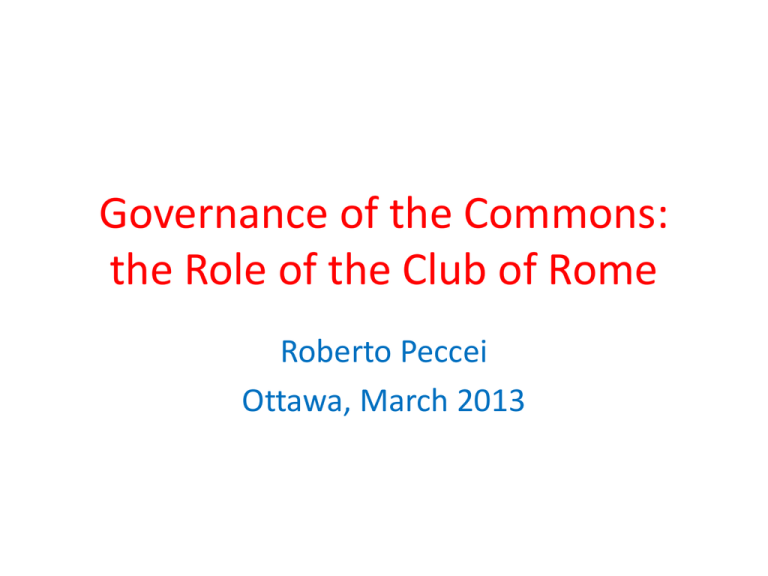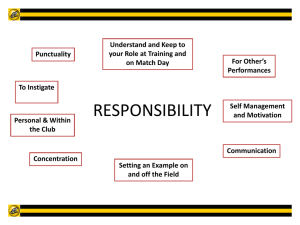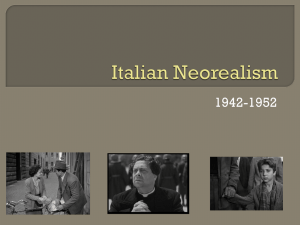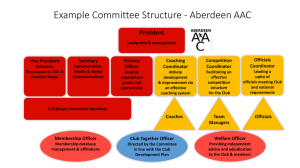presentation
advertisement

Governance of the Commons: the Role of the Club of Rome Roberto Peccei Ottawa, March 2013 Governance of the Commons: the Role of the Club of Rome • The Commons, as understood by the Club of Rome • Conclusions from the MIT Study • The Club of Rome response after Limits to Growth • Governance of the Commons: What can we do? i. The Anthropocene Network ii. The Energy Landscape • Concluding Remarks The Commons, as understood by the Club of Rome • The common in medieval England was an integral part of the manor, but also a piece of land where manoral tenants and others had certain access rights • More generally, the commons now refers to environmental elements (like forests, rivers, oceans, and the atmosphere) that are used, enjoyed and shared by all • The Club of Rome from the beginning took a broader view of the commons, extending it beyond the planet’s biosphere and its elements to include also its man-made institutions • It is this broader commons which needs attention. That is, one needs not only be concerned about the biophysical sources and sinks of materials and energy which keep the biosphere in equilibrium, but one must also be concerned with the plethora of human activities which impinge on the biosphere and have the potential of disturbing this equilibrium. • This broader commons and how it would evolve in the future was the subject of the 1st report to the Club of Rome Limits to Growth • Indeed, the five dynamical variables used to describe the world: Population Industrial output Food availability Pollution Resources are a mixture of biophysical and human parameters Conclusions from the MIT Study • The 1972 report to the Club of Rome of Meadows et al drew three broad conclusions, but most people focused only on the first of these: i. If the present growth trends in world population, industrialization, pollution, food production, and resource depletion continue unchanged, the limits to growth on this planet will be reached sometime within the next one hundred years. The most probable result will be a rather sudden uncontrollable decline in both population and industrial capacity Poster of the standard run in Limits to Growth created for the 1972 Smithsonian presentation shows this overshoot and collapse behavior 1st message is clear: unlimited growth in a finite world leads to overshoot and collapse Limits to Growth - 30 year update Pollution Population Industrial Output Food Resources Meadows Meadows and Randers 2004 • The other two overlooked recommendations, however, make equally important points: ii. It is possible to alter these growth trends and to establish a condition of ecological and economic stability that is sustainable far into the future. The state of global equilibrium could be designed so that the material needs of each person on earth are satisfied and each person has an equal opportunity to realize his individual human potential iii. If the world’s people decide to strive for this second outcome rather than the first, the sooner they begin working to attain it, the greatest will be their chances of success • Thus, for me the real message of Limits to Growth is not that mankind will go through an overshoot and collapse phase, but whether mankind can find an alternative evolutionary path? • Is it really possible for mankind to change course and pursue a less destructive path of development, which might be called Managing of the Commons? • Two questions come immediately to mind: i. Are we too late to change course now? ii. If we are not, what do we need to do to find a different path for human development than the one we are now on? • The 1st question, probably, is the one that it is most difficult to answer • Dennis Meadows is pessimistic on this point. He stresses that since we are too late to aim for sustainability, what we should do is to aim at building resiliency • I am more optimistic. Thus, I think it is still important to understand better the principal things that need to be done to alter the present course, and then try to get them implemented • Can gain some understanding on how to proceed by following the path which the Club of Rome took after the publication of Limits to Growth The Club of Rome response after Limits • The MIT report Limits to Growth validated and confirmed the Club of Rome’s concerns about what they called the predicament of mankind not addressing ↔ cause humanity’s the problematique collapse “The Meadows’ report confirmed and expanded… what I expected” [A. Peccei The Human Quality 1976] “ For most of those already engaged in the zero growth debate, Limits had few surprises” [A. King Let the Cat Turn Around 2006] • However Limits to Growth also caused the Club of Rome to evolve its own thinking, and the Club’s activities after the book was published followed two main paths: i. The COR tried to engender change through high level discussions with leading world political figures e. g. February 1974 Salzburg meeting of the COR with Kreisky, Trudeau, Palme, Senghor, Echeverria, den Uyl and Celio ii. The COR attempted to reinforce the conclusions obtained by Meadows et al by further studies, along three different lines • What were these lines of study, aimed to help support and amplify the message of Limits to Growth and that of the Club of Rome? - Methodological and systemic studies on limits - Studies on the governance required for the world - Studies on the values needed for the future • I will make some brief comments on each, focusing on the reports to the Club of Rome which followed soon after the publication of Limits to Growth • However, essentially all subsequent reports to the Club of Rome follow the same pattern. So these lines of study, traceable to Limits, are the intellectual legacy which the book left to the Club of Rome Methodological and systemic studies on limits - M. Mesarovic and E. Pestel : Mankind at the Turning Point; 2nd Report to the Club of Rome (1974) Global system was disaggregated into ten regional subsystems. Concept of organic growth introduced, allowing different parts of the global system to follow different growth paths - D. Gabor and U. Colombo : Beyond the Age Of Waste; 4th Report to the Club of Rome (1978) T. de Montbrial : Energy: The Countdown; 6th Report to the Club of Rome (1979) These were among the first systemic studies of the sources and sinks of materials in nature which help determine human limits Governance Studies - J. Timbergen: Reshaping the International Order; 3rd Report to the Club of Rome (1976) Proposes to reduce gross global inequities in economic opportunities, to ensure more harmonious growth. Provides the beginning of a global planning system - B. Hawrylyshyn: Road Maps to the Future; 10th Report to the Club of Rome (1980) Analyses the efficiency of various societies and their ways of approaching the future Studies Around Values Needed for the Future - E. Laszlo: Goals for Mankind; 5th Report to the Club of Rome (1978) Addresses the goals mankind will need for the future. These include peace, food security, a rational use of resources and the satisfaction of both the material and spiritual needs of man - J. W. Botkin, M. Elmandjra and M. Malitza: No Limits to Learning; 7th Report to the Club of Rome (1979) Introduces the concept that to bridge the human gap, so as to be prepared for the future, learning must be both participatory and anticipatory - M. Guernier: Tiers-Monde: Trois Quarts du Monde; 8th Report to the Club of Rome (1980) Discusses the widening gap between developed and underdeveloped regions in the world and the resulting inequities caused by poverty, hunger and disease. The future of the world is predicated on closing this gap - O. Giarini: Dialogue on Wealth and Welfare; 9th Report to the Club of Rome (1980) Couples economy and ecology and points out that wealth and welfare cannot exist in an ecologically unhealthy world. Real value is not represented by the cost of production, but is dependent on its utilization over time. Natural capital itself must be valued Governance of the Commons: What can we do? • I tried to give you some sense of how Limits to Growth helped mold the activities of the Club of Rome in its first decade of existence • In its fourth decade, the Club continues to try to effect change by following what is by now a well-trodden path: - Try to privately influence world leaders - Engage in systemic studies of the problematique - Suggest new approaches to governance - Offer reflections on values • These perspectives are the source of some ideas which may help insure a better governance of the commons • In this respect, the following quote from my father is extremely helpful “ Our current ways of thinking reflect ideologies and experiences of a past very different from the present. A wide gap has thus opened between the beliefs, values, principles, norms, frames of reference, and mental attitudes that we normally employ as guides, and those that are now necessary in view of the nature and extent of the challenges of our age” A. Peccei: One Hundred Pages for the Future (1981 • How do we close this gap? • To try to answer this question, I will look at two specific examples, which I hope will be illustrative of the kind of steps which are needed to face the challenges ahead. • In addition, I hope it will be clear through these examples how practically one needs to proceed to better manage the commons • The examples I want to discuss involve: i. The anthropocene network ii. The energy landscape The Anthropocene Network • It has been said by many, starting with Paul Crutzen, that we are now living in a new era: the anthropocene • In this era, human actions and not geology or biology are the dominant influences on the evolution of the planet • In the anthropocene the planet’s sustainability depends on the health of both its natural and manmade habitats and associated infrastructure • Just as ecosystems have inter-related sub-systems, it is useful to think of the interconnected subnetworks that make up the planet’s anthropocene network • Broadly speaking, five such sub-networks can be identified- much like the five variables in Limits to Growth : i. natural and material resources (planetary resources) ii. human-built infrastructure (human infrastructure) iii. agriculture and land resources (agriculture) iv. demography (population) v. waste and pollution (anthropogenic pollution) • Here I want to concentrate on only two of these sub-networks (planetary resources and human infrastructure) and examine their interdependence • In the planetary resources sub-network we need to quantify the stocks of mineral resources, like copper and iron, as well as the rate at which these resources are being consumed. • However, the myriad of natural services that the environment provides are of equal importance to the planetary resources sub-network. These services, like water quality or flood control by forests, are often not given an economic value but are critical to humankind survival. • The anthropocene network depends also on a vast array of human-built infrastructure – cities, roads, canals, bridges, etc • In addition to semi-permanent infrastructure, like buildings, mankind uses and consumes a myriad of goods, like cars and clothes, with a shorter lifetime. • This vast human infrastructure is the fruit of the utilization of natural resources both in the present (consumer goods and new infrastructure) and in the past (built-up infrastructure) • Obviously there are clear linkages between the planetary resources and the human-built infrastructure sub-networks • Here I will focus on only one aspect of this linkage, how planetary resources limit the extent of humanbuilt infrastructure • It is clear that the availability of natural services, like those provided by arable land, forests and aquifers, as well as material resources, like iron or rare earths, ultimately is the limiting constraint for the renewal and growth of human infrastructure. • So one needs to ask what are the planet’s infrastructure needs? • The planetary needs for infrastructure are of two distinct kinds: i. As the population grows and further urbanizes, more man-made infrastructure will need to be built [A good estimate is that by 2050, the required infrastructure will grow by 30-40 %] ii. Although beyond 2050 one can imagine tapering off the building of new infrastructure, it still will be necessary to provide for the continuous renewal of the built-up infrastructure, because of wear and decay [By 2050, a good estimate is that we need to replace 40% of infrastructure] • Enormous challenge to build so much infrastructure in the next 40 years! • To minimize resource depletion and pollution, must significantly increase recycling and efficiency • Further, given this challenge, using natural or material resources for pure consumption makes little sense • We see from this discussion that understanding the needs of the anthropocene network provides useful lessons, and a blueprint, for how to manage the commons! The Energy Landscape • As a second example, let me discuss the energy landscape • Energy use is probably the most fundamental characteristic of the anthropocene • In fact, the level of energy consumption is an important metric. • For instance, stocks of material resources are difficult to quantify, because what is extractable depends on the amount of energy one is prepared to use (Bardi). • Energy is pervasive in modern society. Indeed, in many ways the society we live in is the result of the enormous increase in energy usage in the last 200 years [ 30-fold increase] • Actually, about a factor of 7 of this increase is due to population on Earth going from 1 billion in 1800 to 7 billion now, so per capita energy growth has increased by a factor of 4 One should note, however, that the US and Canada per capita consumption is about 4 times the world’s per capita consumption, of order 10 kW/ person The energy landscape is complex as figure for US shows • Even though the energy landscape is complex, two facts dominate: i. The preponderance of the energy used comes from the combustion of fossil fuels (80-85%) ii. This combustion is accompanied by the emission each year of billions of tons of CO2 ( the 2011 number is 33 billion) with China and the US accounting for almost 50% of the total • The burning of fossil fuels in the last 150-years, which allowed for a factor of 30 increase in energy use in the world, is the main contributor to the significant and continuing increase of CO2 in the atmosphere [Figure] February 2013 396.8 ppm CO2 • It is widely believed that the anthropogenic increase of CO2 in the atmosphere is responsible for the global warming of the planet and, more generally, for climate change NASA Goddard Compilation ΔT = 0.8 ⁰C • Effects of climate change may already be moving our planet beyond various tipping points Artic sea ice may well disappear in a few years • Furthermore, there are significant delayed effects • The planet is slow to react to increases in CO2 in the atmosphere, so the earth’s temperature will rise further • It has been estimated by Jim Hansen that, if the CO2 level remained at its present level, then the temperature of the earth will eventually rise by another 1.2⁰ C, so ΔTtotal = 2 ⁰ C. • If emissions from fossil fuel burning keep increasing CO2 in the atmosphere, then the earth’s temperature could reach ΔT = 4 ⁰ C by the end of this century • However, ΔT = 2 ⁰ C is already a big problem, if one looks at paleoclimate data • Look at geologic record: • Figures from Hansen and Sato paper have a temperature scale where T peak hol ≈ 2 ⁰ C , so an additional ΔT= 2 ⁰ C corresponds to T≈ 4 ⁰ C • The earth’s temperature was this hot last about 40 million years ago! • Lesson to be drawn from this discussion is that strong steps need to be taken to maintain, or preferably bring down, the CO2 levels in the atmosphere • Trends are not encouraging: i. The level of CO2 keeps increasing Δ [CO2 2012]= + 3.3 ppm ii. Transition away from fossil fuels into renewable energies not moving very rapidly, because of renewed focus on unconventional fossil fuel reserves [water fracking; shale oil; etc] with great potential to increase CO2 emissions [Figure] If unconventional fossil fuels are tapped, the concomitant rise in the concentration of CO2 in the atmosphere will alter the earth climate in a major (and vastly unknown) way • If we want to preserve the commons, we need to take steps to act prudently in connection with the energy landscape. • Given the looming climate threat, it is important to move as rapidly as feasible to de-carbonize the energy we consume • This does require some technological breakthroughs in renewable energies ( advanced photovoltaic materials, 3rd generation biofuels, etc) • However, it also requires a real will to move away from the present dependence on fossil fuels, by stopping subsidizing the fossil fuel industry • For a country like Canada, rich in fossil resources, decarbonizing its energy use will prove to be really a challenge, but it is important to begin planning this transition and put it into place • Secondly, it is important to reduce the energy intensity of the economy by improving the efficiency of energy use • Here a minimum goal would be to totally absorb the 30% extra energy demand in 2050 due to demography, through efficiency gains. This would require roughly a 1%/year gain in energy efficiency- an achievable goal Concluding Remarks • I tried to give you some idea of how the Club of Rome has approached the governance of the commons • I did this here by examining past reports to the Club of Rome and through two specific examples, dealing with aspects of the anthropocene network and the energy landscape • The guiding philosophy is that life is a cooperative activity, where individual choices determine our collective fate and where living in harmony with nature is essential for humanity’s survival • I do not know if our, and other’s, attempt to better govern the commons will help change our planet’s present course enough, so as to avoid the overshoot and collapse scenarios of Limits to Growth • Nevertheless, I believe we must continue to provide reasoned and impassioned arguments for moving mankind away from the “business as usual” path, something the Club of Rome has done for the past 40 years- not as prophets of doom but as messengers of hope








